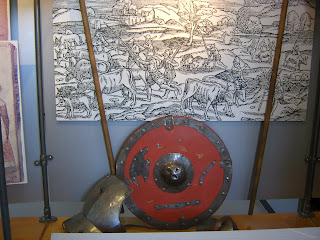The estate of Ford & Etal is situated about ten miles inland from Holy Island, and on the estate are all kinds of attractions to visit.
A fifteen inch gauge steam railway links Heatherslaw Mill (which is a restored working corn mill, complete with a waterwheel to grind the corn, as well as a cafe selling produce cooked from the ground flour, and a visitor centre) to the village of Etal. A trip on this railways follows the course of the River Till and if you are lucky you will see various forms of wildlife - squirrels, water creatures and herons and kingfishers to name but a few of the species around.
Etal is a very pretty and picturesque village with the only thatched pub in Northumberland.
The Black Bull in Etal - the only thatched pub in Northumberland
You will also find the Lavender Tearooms in the village Post Office!
The ford across the River Till
Heron at Etal on the lookout for fish
Dotted around the estate are various craftsmen - Errol Hut Smithy - (blacksmiths) & Woodwork Shop, Taylor & Green (furniture makers) and Heatherslaw Mill (corn millers and bakers).
There are also the remains of a Castle and Gatehouse at Etal, and a museum devoted to Border Warfare.
Dot & Ruby approaching Etal Castle Museum
Border Warfare Display in Etal Castle Museum
Border Warfare Display in Etal Castle Museum
Etal Castle
Etal Castle Gatehouse from the inside
Etal Castle Gatehouse from the Outside
A couple of miles along the road is the estate village of Ford, with houses similar in design to those at Saltaire.
The centrepiece of the estate is Ford Castle. It is believed to have been built or rebuilt by Sir William Heron in 1287. Because of its close proximity to Scotland the Castle suffered frequent attacks by the Scots. It is known that James IV of Scotland stayed here prior to the Battle of Flodden in 1513. The Castle was completely rebuilt by Sir John Hussey Delaval between 1761 and 1764. It was completely restored by Louisa, Marchioness of Waterford, between 1861 and 1863. During WW2 the Castle was used by the Red Cross as a convalescent hospital. In recent years Northumberland County Council has leased the Castle for use as an educational establishment.
Another feature in the village is the Lady Waterford Hall. The Hall was built in 1860 to be used as a school. Louisa, Marchioness of Waterford had a strong interest in the school. She financed the building and between 1861 and 1883 painted a series of murals that can still be seen in the Hall. The school closed in 1957 but the Hall remains open for public viewing.
Lady Waterford Hall - interior, showing paintings

Lady Waterford Hall - exterior
There is a tall column (which used to be a fountain - called Ford Fountain) with an angel on the top at one end of the village, and a cottage called Jubilee Cottage at the other end of the village.
Ford Fountain
Ford Fountain - the angel on the top
Looking up the village to Jubilee Cottage
Jubilee Cottage
Jubilee Cottage - detail
No prizes for guessing what Forge Cottage used to be.
The doorway is a giveaway!

















No comments:
Post a Comment